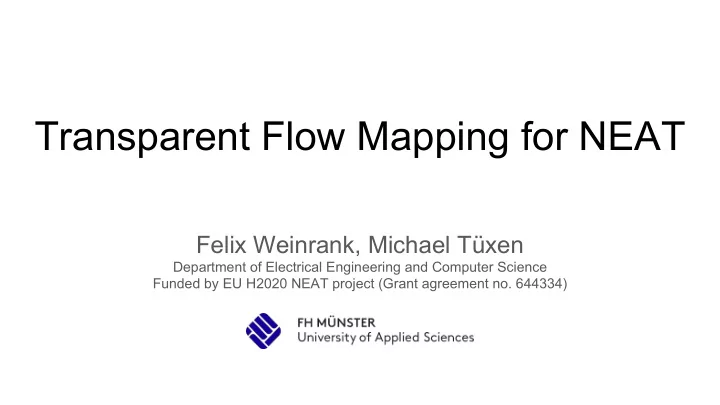

Transparent Flow Mapping for NEAT Felix Weinrank, Michael Tüxen Department of Electrical Engineering and Computer Science Funded by EU H2020 NEAT project (Grant agreement no. 644334)
In a nutshell Automatic multiplexing + fallback Transparent for the application No additional coding effort 2
Multiplexing ● Bundling of several data paths to a single transport connection ● Key feature in widely used protocols ○ HTTP2 (TCP) ○ QUIC (UDP) ○ WebRTC Data Channel (SCTP) 3
Multiplexing - Pros and Cons ● Pros ○ Flow- and congestion-control mechanisms benefit from larger quantities of transferred data ○ Higher packet rates result in quicker loss detection ○ Shared congestion window is beneficial for new connections and connections with a low sending rate ○ Reduced amount of connections improves server capacities ● Cons ○ Additional coding effort ○ Fallback mechanism (optional) 4
NEAT Library ● Userland library for network communication ● Non-blocking and callback-based concept ● Unified API for all network protocols ● Supports (MP)TCP, UDP, SCTP (Kernel + Userland) ● Runs on Linux, FreeBSD, NetBSD and macOS ● Based on libuv ● www.neat-project.org 5
NEAT - Flow ● Bi-directional communication channel between two application endpoints ● Handles DNS resolution, buffer management, ... ● Can be grouped ● Unified API for all supported protocols ○ neat_open() ○ neat_write() ○ neat_read() ○ neat_close() ○ ... 6
Transparent Flow Mapping (TFM) - Concept ● Mapping multiple NEAT flows to a single transport connection while behaving like a 1:1 mapped flow 7
TFM - Requirements and Negotiation ● Both sides have to support ○ SCTP ○ SCTP - Stream Reconfiguration extension ○ SCTP - User Message Interleaving (IDATA) extension ● Support for TFM is negotiated via SCTP’s adaptation layer indication value ○ Carried via INIT / INIT-ACK chunk ○ TFM for NEAT specific value ○ If set by both sides → TFM support negotiated 8
TFM - Flow creation ● Transparent mapping of a new flow requires an existing flow with ○ Same destination IP / DNS-Name ○ Same port number ○ SCTP connection ○ Unused SCTP stream ○ TFM support ● New flow is instantly mapped to existing transport connection ○ Zero RTT connection setup 9
TFM - Data Transmission 10
TFM - Flow Teardown ● Using SCTP’s Stream Reset extension for closing procedure 11
TFM - Measurement Scenario ● NEAT application using two flows, same target, low sending rate ● Comparing “1:1 mapping” vs “transparent flow mapping” ● Focus: Application-to-Application delay ● UDP background traffic 12
TFM - Measurement Results 13
TFM - Alternative Transport Protocols ● Our implementation uses SCTP with extensions ● Transparent approach allows usage of alternative protocols ○ Easy integration into Happy-Eyeballs mechanism ● Interesting Candidate: Google’s QUIC ○ Quick UDP Internet Connections ○ Multiplexing concept ○ Built-in encryption ○ Zero-RTT connection setup ○ Not standardized (yet) 14
Conclusion and Outlook ● Multiplexing without additional effort for the developer ● Automatic negotiation and integrated fallback solution ● Beneficial for multiple flows with a low sending rate ○ Faster loss detection ○ Congestion-Window reusage ○ Less server load ● Approach allows seamless integration of alternative protocols like QUIC 15
Questions? :) 16
Recommend
More recommend